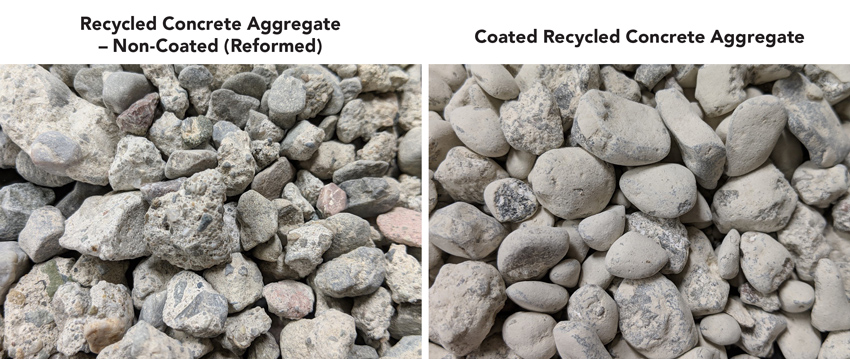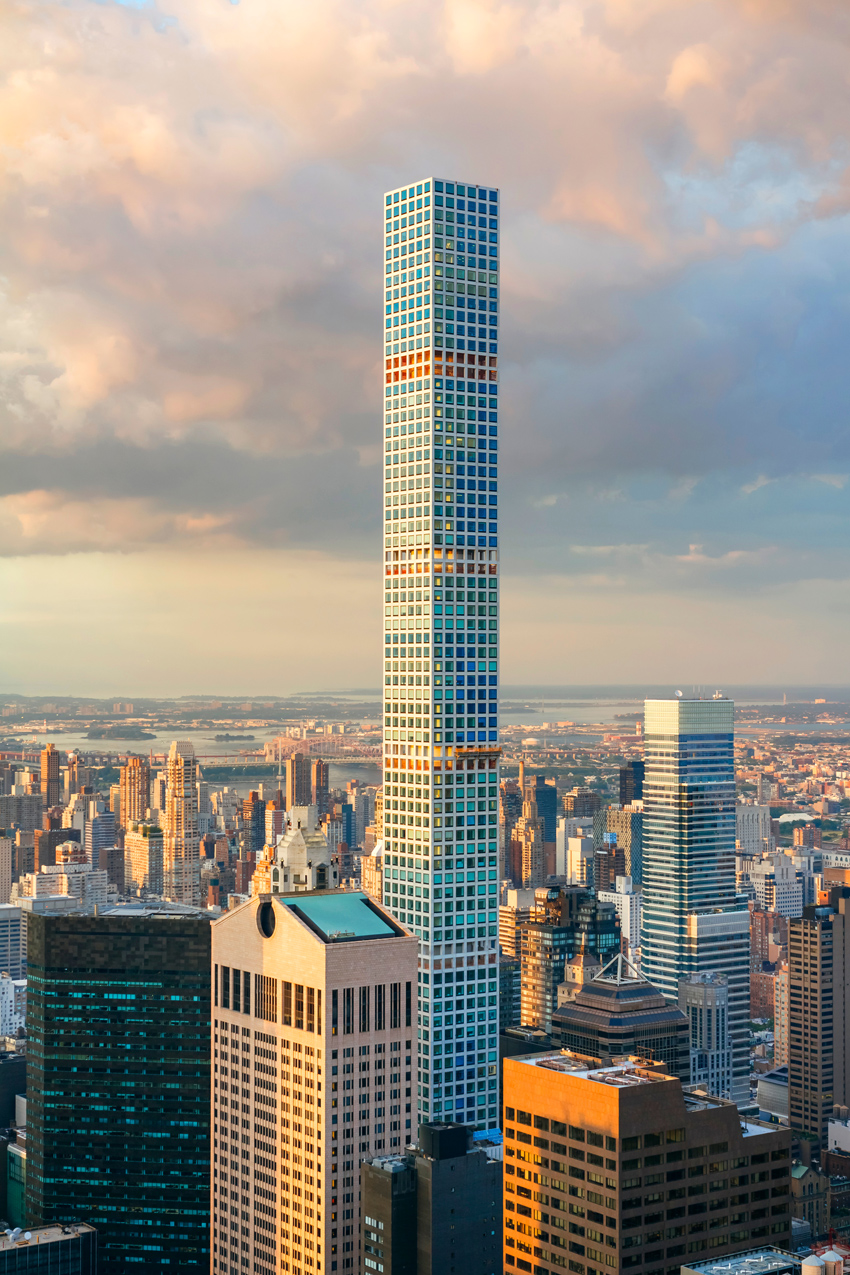Concrete Innovations
Self-Consolidating Concrete
Self-consolidating concrete (SCC) is highly flowable, non-segregating concrete that can flow into place, fill formwork, and encapsulate reinforcement without any mechanical vibration. SCC relies upon a combination of a high proportion of fine aggregate and admixtures called superplasticizers and viscosity modifiers to achieve a stable and highly flowable concrete.
The increased ease of use and efficiency of SCC during construction is the basis for many of its principal benefits. First, it can be placed faster than regular concrete while requiring less finishing and no mechanical vibration. It also improves the uniformity of in-place concrete as well as the uniformity of surfaces, reducing or eliminating the need for surface work.
Additionally, using SCC allows for labor savings as well as increased job-site safety, as it does not require workers to travel the surface of slabs or the tops of walls to mechanically vibrate the concrete. SCC saves time during construction, resulting in cost savings as well as improving the pumpability of the concrete and the turnaround times of concrete trucks.
SCC was first developed in 1986 by Professor Okamura at Ouchi University in Japan to address shortages in skilled labor. At first, SCC was used in highly specialized projects, such as in repair work or difficult-to-reach areas, due to its high cost of production and need for high quality control. The first high-production use of SCC was in precast applications, where concrete is produced and placed in controlled conditions. In ready-mixed concrete applications, SCC was used primarily for heavily reinforced sections and where mechanical vibration was difficult. More recently, SCC is being used in architectural concrete since it results in a surface finish that is superior to that of conventional concrete. SCC still has a relatively high cost, but it is gaining popularity where labor is in short supply or smooth, exposed concrete is desired.
One of the highest-profile uses of SCC is in high-rise buildings, proving its commercial viability and success in practical applications. Some considerations to take into account regarding this concrete stem from the fact that it is dependent upon flowability, which may be reduced by hot weather, long haul distances, or job-site delays. Specifications required for a given job such as flowability and spread can vary, but mixtures can be tested via methods including the slump flow test to determine the extent of the concrete’s plastic properties to ensure that the concrete arriving at a job site matches the standards specific to the project itself. SCC is fully commercialized and used all over the world.

Photos courtesy of Blue Planet
Recycled concrete particles are coated with synthetic limestone, forming a coating that is 44 percent by mass CO2.
From Waste to Worth
Supplementary cementitious materials (SCMs) such as fly ash, slag cement, and silica fume are the keys to high-performance concretes. What makes these materials so innovative is that most are derived from a waste—byproducts of a manufacturing process that would otherwise end up in landfills. But when these waste materials are combined with portland cement in concrete, they react with certain chemical compounds to produce more binder. As a result, these materials are extremely valuable as SCMs.
Silica Fume, Blast Furnace Slag, and Coal Ash
Silica fume is a waste byproduct of processing quartz into silicon or ferro-silicon metals in an electric arc furnace. Silica fume consists of superfine, spherical particles that when combined with cement significantly increases the strength and durability of concrete. Of the three main SCMs, silica fume has the lowest supply and the highest cost, usually at least three times that of portland cement. It is used in applications where extremely high strength is needed, such as columns in high-rise buildings, or where extremely low permeability is desired for durability, such as bridge and parking decks. It is typically combined with other SCMs to optimize performance and cost.
Blast furnace slag is the waste byproduct of iron manufacture. After quenching and grinding, the blast furnace slag takes on much higher value as an SCM for concrete. Blast furnace slag is used as a partial replacement for cement to impart added strength and durability to concrete. Some slag is used to make lightweight aggregate for concrete. About 16 million tons of slag were produced in the United States, but less than half that was used in concrete as an SCM. Slag cement costs about the same or slightly more than cement depending on quality and location.
Coal ash is the waste byproduct of burning coal in electric power plants. Fly ash, a common SCM used in concrete, is one component of coal ash. According to the American Coal Ash Association (ACAA), in 2017, 111.4 million tons of coal ash were produced, of which 38.2 million tons were fly ash. Coal ash and fly ash have many uses, ranging from use in concrete as an SCM to synthetic gypsum for wallboard to mining applications. Of the 38.2 million tons of fly ash produced, only 14.1 million tons are used in concrete.
Fly ash is the most plentiful of all SCMs and is roughly half the cost of portland cement. However, because of increased emissions regulations on coal-fired power plants, not nearly as much high-quality fly ash is produced as in the past. In addition, with a move toward renewables and natural gas, coal-fired power plants are closing, and thus many cost-effective supplies are diminishing.
Because coal power generation started in the early 1900s in the United States, but the use of fly ash in concrete was only started to any significant volume in the late 1900s, it is estimated that about 1.5 billion tons of coal ash has been placed in landfills, of which some is fly ash—and this is where the innovation comes in. Several companies, understanding that the demand for fly ash in concrete is likely to increase, have begun to recover fly ash from landfills and treat it using a process called beneficiation.
Beneficiation simply means taking coal ash from landfills and processing it so it meets the necessary standards for beneficial use. For fly ash, this typically means reducing the amount of unburned carbon in the ash. Carbon tends to have an absorptive quality, which inhibits air-entraining and water-reducing admixtures. There are also other chemicals such as ammonia in some coal ash deposits that must be reduced before use in concrete.
Several companies have developed processes for harvesting ash from landfills and reducing the unburned carbon and ammonia, calcium, sulfur, and other impurities. The simplest process is to burn off the excess carbon. Still other methods use chemical treatment to mitigate the effects of carbon and ammonia, and one company uses low-frequency sound to reduce the size of particles to make them more uniform, which is a desired characteristic of fly ash.
According to an article titled “Digging Through the Past: Harvesting Legacy Ash Deposits to Meet Future Demand” published in a 2019 issue of Ash at Work magazine, author Rafik Minkara concludes, “While the variety of technologies now exist to beneficiate land-filled and ponded ash, the cost and complexity of doing so can be challenging.” He goes on to say, “Beneficiation processes can be as simple as using off-the-shelf equipment or as involved as developing customized solutions with high capex requirements.” In the end, it will depend on demand for fly ash. As low-cost supplies diminish over time, the demand is likely to be filled by harvesting and beneficiating the vast supply of coal ash currently in landfills.
Blended Cements
Most SCMs are added at the concrete plant to supplement portland cement. However, there are several alternatives to portland cement called blended cements. These combine ordinary portland cement (OPC) with other materials at the cement plant. The most common type of blended cement is portland limestone cement (PLC), or technically ASTM C595 Type IL (pronounced “one el”) cement. This blended cement combines up to 15 percent limestone interground with OPC to make a cement with a carbon footprint that is up to 10 percent lower than OPC with performance that is identical to—and in some cases better than—OPC.
There are four types of blended cements in ASTM C595:
- Type IL (X) Portland-Limestone Cement, where X can be between 5 and 15 percent limestone.
- Type IS (X) Portland-Slag Cement, where X can be up to 95 percent slag cement.
- Type IP (X) Portland-Pozzolan Cement, where X can be up to 40 percent pozzolan (fly ash is the most common).
- Type IT (AX)(BY) Ternary Blended Cement, where X and Y are the percentages of slag cement, pozzolan, or limestone, and A and B are the types of ingredients (S, P, or L). The total of X + Y cannot be more than 70 percent, with pozzolan being no more than 40 percent and limestone no more than 15 percent.
Blended cements are accepted in all the concrete standards.










